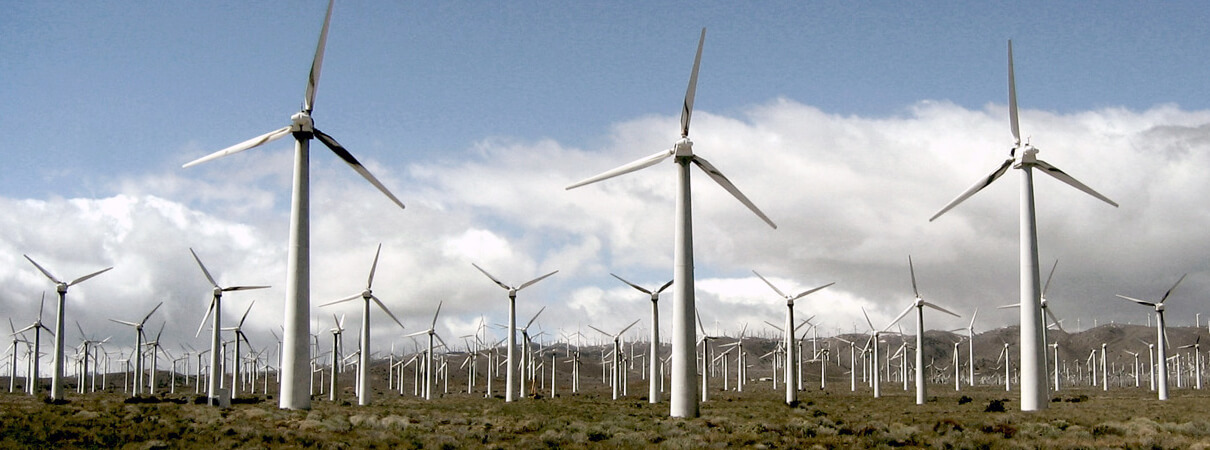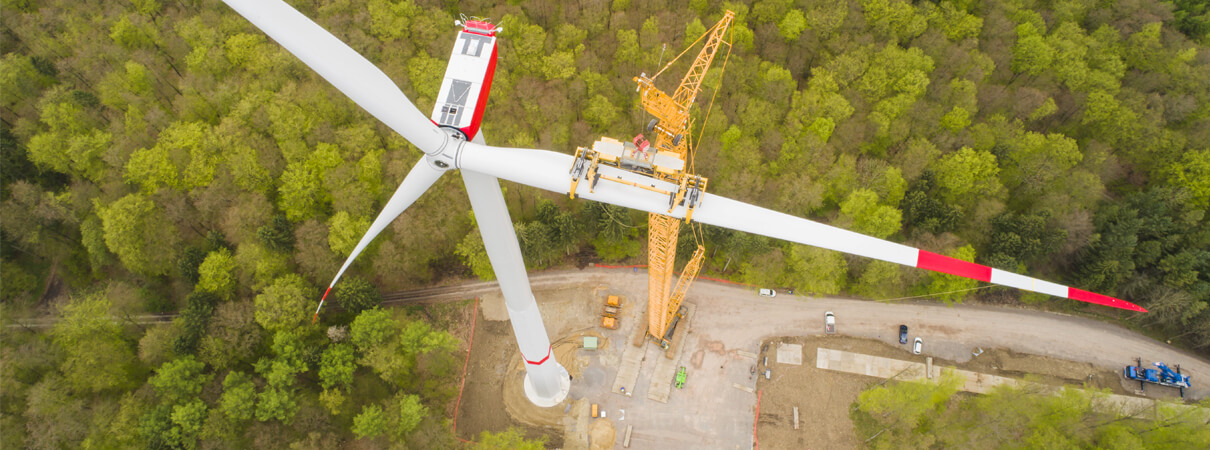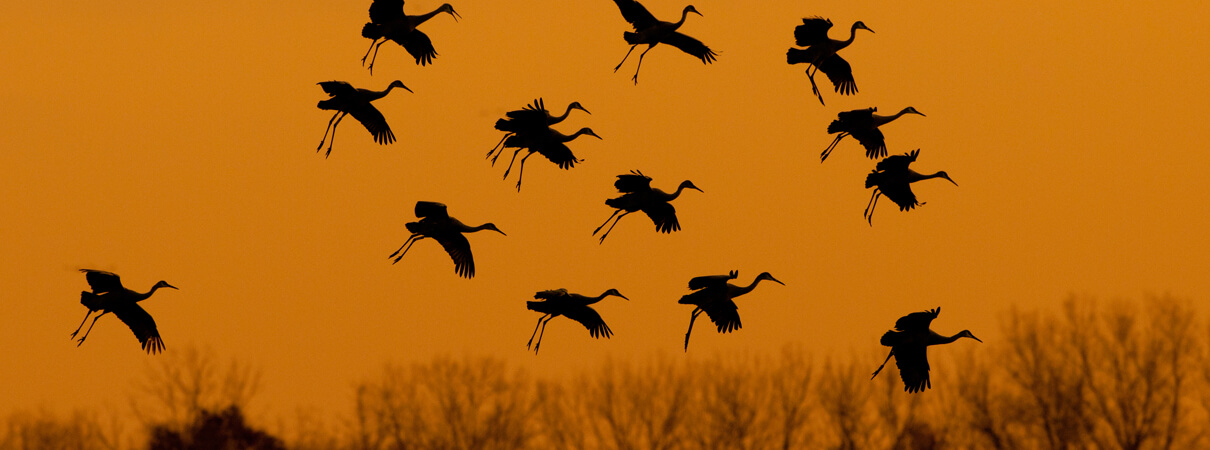Top 10 Myths About Wind Energy and Birds
Wind energy is known to many as a “green” solution to climate change. But wind energy is really just another form of industrial development, and we can't ignore its costs and consequences to wildlife and their habitats. As Director of ABC's Bird-Smart Wind Energy Campaign, I often encounter several common misconceptions about wind development. Read on to learn more about the real impact of unchecked wind energy development on birds and other wildlife.

We can't ignore wind energy's consequences for wildlife. Photo by stock.xchng
Myth 1: Wind turbines are “green” energy with little or no impact on the environment.
Any form of energy production, including renewable energy, has environmental impacts. The construction of large-scale, commercial wind energy facilities takes up entire landscapes, which reduces wildlife habitat. And the maintenance roads and other support infrastructure necessary also alter habitats and affect wildlife, often in very deleterious, subtle ways. If not properly sited, operated, and regulated, renewable energy can be very harmful to wildlife and natural habitats.
Myth 2: We shouldn't be concerned about wind energy because it doesn't take nearly the same toll on birds as feral cats, building collisions, pesticides, and other threats.
There are two things to remember here. First, wind turbines' impacts are far from trivial. And the impacts of all human-caused mortality are cumulative, making comparisons irrelevant and misleading.
Wind turbines and their associated infrastructure — primarily power lines and towers — are one of the fastest-growing threats to birds in the United States and Canada. At the end of 2016, there were more than 52,000 commercial-scale wind turbines operating in the United States, and tens of thousands more are currently planned or under construction. Research shows that hundreds of thousands of birds and bats die every year when they accidentally collide with the fast-spinning turbine blades. That number grows with each turbine built.

A Ferruginous Hawk colliding with a power line. Photo by Brenda Carson/Shutterstock
Myth 3: Power lines and towers are a separate issue.
Power lines and towers are clearly part of the equation, because they're necessary to carry power to the grid. As a result of large-scale, commercial wind and solar development, hundreds of miles of new power lines and towers are being built to transport energy across the United States, putting birds at risk of collisions and electrocutions. The generation of energy and its transportation go hand in hand — and both present risks to wildlife. Tens of millions of birds are killed every year when they collide with towers or are electrocuted by electrical lines.
Myth 4: The wind industry is mitigating for bird and bat deaths.
As far as birds are concerned, only two mitigation methods have been proven to be successful: building wind energy facilities away from large concentrations of birds, and slowing or stopping the movement of turbine blades (known in the industry as “curtailment”). Unfortunately, neither of these approaches is working. Turbines are going up virtually everywhere, and curtailment is unpopular with wind companies because it cuts into their profit margins.
Some companies say they use radar to detect birds and bats and then temporarily shut down a turbine's blades. But these technologies are expensive and appear to be seldom used — and their efficacy in preventing bird and bat deaths has not been thoroughly tested.

One way to make wind turbines safe for birds and bats, such as this Northern Long-eared Bat, is to build them far from large concentrations of these animals. Photo by U.S. Fish and Wildlife Service
Myth 5: The U.S. Fish & Wildlife Service (FWS) and state wildlife agencies are regulating the wind industry to minimize its impacts on wildlife.
We have at least three federal laws designed to protect our native birds and bats from purposeful or accidental harm: the Endangered Species Act, the Migratory Bird Treaty Act, and the Bald and Golden Eagle Protection Act. Enforcement of these laws has been sporadic at best, especially with regard to the wind industry. To make matters worse, federal guidelines governing wind energy development are voluntary, not mandatory, and few developers at present are obtaining the “take” permits necessary to kill protected species.
Meanwhile, state and local regulation of the wind industry varies widely. Some states, such as Oklahoma, have virtually no regulations at all. Others, like Hawai‘i, have more-stringent policies. Wind energy has developed so rapidly that it has gotten way out ahead of the regulatory framework.
Myth 6: Wind companies conduct scientifically rigorous studies before and after new facilities are built to assess the risks wind turbines pose to birds — and are transparent in what they find.
Federal guidelines currently allow wind companies to hire consultants to prepare reports assessing a proposed facility's risk for wildlife. It's important to note that these are not independent, third-party scientists; they are individuals who are being paid by wind companies to do this work. Unsurprisingly, I have yet to encounter any pre-construction study that recommends moving a proposed project because of elevated risks to wildlife.

A Snowy Owl perched near a power line. Tens of millions of birds are killed every year when they collide with towers with or are electrocuted by electrical lines. Photo by Pictureguy/Shutterstock
There is also the problem of hidden data. The wind industry treats information on bird and bat mortality as a proprietary trade secret. Some wind energy developers have even sued to hide these data from the public. Hawai‘i is currently the only state that requires the collection of mortality data by independent, third-party experts, and makes the information available to the public on request.
Myth 7: Offshore wind development is less destructive than onshore wind development.
There's no indication that turbines placed in the open ocean or in the Great Lakes are any safer for birds than land-based turbines. A whole suite of different organisms could be impacted by offshore wind development and underwater cables, including migrating marine birds, waterfowl, cetaceans, fish, and other ocean-dwelling wildlife. And it's going to be more difficult to gauge the impact: risk assessments are often based on visual observations, which can be difficult, if not impossible, during rough weather, when birds may be at highest risk. What's more, birds that collide with the turbine blades will fall into open water and be lost.

Offshore wind facilities like this one are likely to affect a suite of different marine organisms. Photo by anderm/Shutterstock
Myth 8: We can build wind turbines in and around the Great Lakes with little or no impact on wildlife.
The best way to reduce the impacts of wind energy on birds and bats is to keep turbines away from large concentrations of these animals. Major migratory routes, stopover habitat, and key breeding or foraging areas should all be off-limits for wind development. Yet all of these are found in and around the Great Lakes, which is home to one of the world's densest concentrations of migratory birds and bats.
Here at ABC, we oppose wind turbine construction in the Great Lakes and within at least five miles of its shorelines. We base our position on recent advanced radar studies conducted by the FWS on all five of the Great Lakes. All of the studies clearly show vast numbers of birds and bats flying over the lakes or along their shorelines, many within the rotor-swept areas of wind turbines. The FWS currently recommends that no turbines be built within three miles of the Great Lakes shorelines, while the Nature Conservancy recommends five miles. However, these are just recommendations, and some wind developers are disregarding them.

A wind turbine under construction. Wind energy has developed so rapidly the regulatory framework has been unable to keep up. Photo by P. Heitmann/Shutterstock_U
Myth 9: When it comes to combating climate change, there are no workable alternatives to industrial-scale wind energy.
There are many other ways we can address climate change besides building these huge structures in ecologically sensitive areas. We can preserve wetlands and forests to sequester carbon dioxide; we can be more energy-efficient; and we can reduce our use of fossil fuels and rely less on domestic animals (a major source of greenhouse gases) as a protein source, for starters. One of the best options is distributed solar in our already built environment — parking lots, buildings, and roads.
Myth 10: Climate change is the top threat to wildlife today; we can ignore all other threats because they pale in comparison.
Birds and other wildlife confront many threats, and they add up. One recent analysis of 8,000 species on the International Union for Conservation of Nature Red List of Threatened Species found that climate change is not the most immediate threat to wildlife today; that distinction went to the traditional threats of over-exploitation (overfishing, hunting, and so on) and habitat loss from agriculture. The authors concluded that “efforts to address climate change do not overshadow more immediate priorities for the survival of the world's flora and fauna.”

Sandhill Cranes in flight. Powerlines and towers are known to be one of the biggest killers of cranes worldwide. Photo by Rob Stokes/Shutterstock
We support wind energy development that's done in ways that do not threaten our irreplaceable and ecologically important wildlife. To make that happen, wind energy development must be regulated more effectively. We must address climate change, to be sure — but the point is that we could be doing it so much better.
 Michael Hutchins, Director of American Bird Conservancy's Bird-Smart Wind Energy Campaign, earned his Ph.D. in animal behavior at the University of Washington. Prior to ABC, Michael was Director/William Conway Endowed Chair, Department of Conservation and Science, at the Association of Zoos and Aquariums for 15 years, and Executive Director/CEO at The Wildlife Society for seven years. He has authored over 220 articles and books on various topics in wildlife science, management, and conservation, and has traveled to over 30 countries to pursue his passion for conservation.
Michael Hutchins, Director of American Bird Conservancy's Bird-Smart Wind Energy Campaign, earned his Ph.D. in animal behavior at the University of Washington. Prior to ABC, Michael was Director/William Conway Endowed Chair, Department of Conservation and Science, at the Association of Zoos and Aquariums for 15 years, and Executive Director/CEO at The Wildlife Society for seven years. He has authored over 220 articles and books on various topics in wildlife science, management, and conservation, and has traveled to over 30 countries to pursue his passion for conservation.


















































